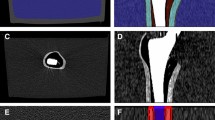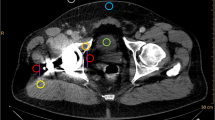Abstract
Objective
This study aimed to evaluate the effect of the metal artifact reduction (MAR) method on quantitative single-photon emission computed tomography (SPECT)/computed tomography (CT) to reveal the usefulness of MAR in patients with metal implants.
Methods
We performed a phantom experiment simulating patients with artificial hip prostheses using SPECT/CT equipped with the iterative MAR (iMAR). The phantom was filled with Tc-99m solution (29.5 kBq/mL). For the CT scan conditions, tube current time products were applied to obtain volume CT dose indexes (CTDIvols) of 1.4, 2.8, and 5.6 mGy. Six types of quantitative SPECT images were reconstructed using data from different doses of CT processed with and without iMAR for CT attenuation correction. Thirty circular regions of interest (ROIs) were placed in each of the dark-band artifact areas, the white-streak artifact areas, and the non-artifact areas. We calculated radioactivity concentrations from quantitative SPECT images with and without iMAR to evaluate the quantitative accuracy. The differences of the effect of iMAR with different CT doses were also evaluated.
Results
The results obtained using CT data with a CTDIvol of 2.8 mGy are described below. For quantitative SPECT data without iMAR, we observed the underestimation of radioactivity concentration in the dark-band artifact areas and overestimation in the white-streak artifact areas. We observed quantification errors ranging from − 41.1% to + 20.0% without iMAR, depending on the ROI localization. When iMAR was used, these errors were reduced to a range of − 22.8% to + 14.2%. The mean absolute error from the true value in the artifact regions was also significantly reduced from 4.00 to 1.74 kBq/mL. In the non-artifact areas, the radioactivity concentrations obtained from the quantitative SPECT data with and without iMAR were equivalent to the true value and did not differ significantly between the two conditions. Similar results were observed for procedures with CTDIvols of 1.4 and 5.6 mGy.
Conclusions
This study indicated that iMAR could improve the quantitative accuracy of SPECT/CT independent of the CT dose. iMAR can serve as a practicable technique for quantitative SPECT/CT in patients with metal implants.






Similar content being viewed by others
References
Fricke E, Fricke H, Weise R, Kammeier A, Hagedorn R, Lotz N, et al. Attenuation Correction Of Myocardial SPECT perfusion images with low-dose CT: evaluation of the method by comparison with perfusion PET. J Nucl Med. 2005;46:736–44.
Filippi L, Schillaci O. Usefulness of hybrid SPECTCT in 99mTc-HMPAO–labeled leukocyte scintigraphy for bone and joint infections. J Nucl Med. 2006;47:1908–13.
Horger M, Bares R. The role of single-photon emission computed tomography/computed tomography in benign and malignant bone disease. Semin Nucl Med. 2006;36(4):286–94.
Gnesin S, Leite Ferreira P, Malterre J, Laub P, Prior JO, Verdun FR. Phantom validation of Tc-99m absolute quantification in a SPECT/CT commercial device. Comput Math Methods Med. 2016;2016:4360371.
Zeintl J, Vija AH, Yahil A, Hornegger J, Kuwert T. Quantitative accuracy of clinical 99mTc SPECT/CT using ordered-subset expectation maximization with 3-dimensional resolution recovery, attenuation, and scatter correction. J Nucl Med. 2010;51(6):921–8.
Bailey D, Willowson K. An Evidence-based review of quantitative SPECT imaging and potential clinical applications. J Nucl Med. 2013;54:83–9.
Kuji I, Yamane T, Seto A, Yasumizu Y, Shirotake S, Oyama M. Skeletal standardized uptake values obtained by quantitative SPECT/CT as an osteoblastic biomarker for the discrimination of active bone metastasis in prostate cancer. Eur J Hybrid Imaging. 2017;1(1):2.
Suh M, Lee W, Kim Y, Yun P, Kim S. Maximum SUV of 99mTc HMDP SPECTCT for the evaluation of temporomandibular joint disorder. Radiology. 2016;280:890–6.
DiFilippo F, Brunken R. Do implanted pacemaker leads and ICD leads cause metal-related artifact in cardiac PET/CT? J Nucl Med. 2005;46:436–43.
Suzuki A, Koshida K, Matsubara K. Effects of pacemaker, implantable cardioverter-defibrillator, and left ventricular leads on CT-based attenuation correction. J Nucl Med Technol. 2014;42(1):37–41.
Meyer E, Raupach R, Lell M, Schmidt B, Kachelriess M. Normalized metal artifact reduction (NMAR) in computed tomography. Med Phys. 2010;37(10):5482–93.
Meyer E, Raupach R, Lell M, Schmidt B, Kachelriess M. Frequency split metal artifact reduction (FSMAR) in computed tomography. Med Phys. 2012;39(4):1904–16.
Martin O, Aissa J, Boos J, Wingendorf K, Latz D, Buchbender C, et al. Impact of different metal artifact reduction techniques on attenuation correction in 18F-FDG PET/CT examinations. Br J Radiol. 2019;92:20190069.
van der Vos CS, Arens AIJ, Hamill JJ, Hofmann C, Panin VY, Meeuwis APW, et al. Metal artifact reduction of CT scans to improve PET/CT. J Nucl Med. 2017;58(11):1867–72.
Loening A, Gambhir S. AMIDE: a free software tool for multimodality medical image analysis. Molecular Imaging. 2003;2:131–7.
Cohen J. Statistical power analysis for the behavioral sciences, 2nd ed. Lawrence Erlbaum Associates; 1988.
Kotsenas AL, Michalak GJ, DeLone DR, Diehn FE, Grant K, Halaweish AF, et al. CT metal artifact reduction in the spine: can an iterative reconstruction technique improve visualization? AJNR Am J Neuroradiol. 2015;36(11):2184–90.
Subhas N, Primak AN, Obuchowski NA, Gupta A, Polster JM, Krauss A, et al. Iterative metal artifact reduction: evaluation and optimization of technique. Skeletal Radiol. 2014;43(12):1729–35.
Abdoli M, Dierckx R, Zaidi H. Metal artifact reduction strategies for improved attenuation correction in hybrid PET/C Timaging. Med Phys. 2012;39(6):3343–60.
Harnish R, Prevrhal S, Alavi A, Zaidi H, Lang TF. The effect of metal artefact reduction on CT-based attenuation correction for PET imaging in the vicinity of metallic hip implants: a phantom study. Ann Nucl Med. 2014;28(6):540–50.
Schabel C, Gatidis S, Bongers M, Hüttig F, Bier G, Kupferschlaeger J, et al. Improving CT-based PET attenuation correction in the vicinity of metal implants by an iterative metal artifact reduction algorithm of CT data and its comparison to dual-energy-based strategies: a phantom study. Invest Radiol. 2017;52:61–5.
Etemadi Z, Ghafarian P, Bitarafan-Rajabi A, Malek H, Rahmim A, Ay MR. Is correction for metallic artefacts mandatory in cardiac SPECT/CT imaging in the presence of pacemaker and implantable cardioverter defibrillator leads? Iran J Nucl Med. 2018;26:35–46.
Katsura M, Sato J, Akahane M, Kunimatsu A, Abe O. Current and novel techniques for metal artifact reduction at CT: practical guide for radiologists. Radiographics. 2018;38(2):450–61.
Haramati N, Staron R, Mazel-Sperling K, Freeman K, Nickoloff E, Barax C, et al. CT scans through metal scanning technique versus hardware composition. Comput Med Imaging Graph. 1994;18:429–34.
Lee M, Kim S, Lee S, Song H, Huh Y, Kim D, et al. Overcoming artifacts from metallic orthopedic implants at high-field-strength MR imaging and multi-detector CT. Radiographics. 2007;27:791–803.
Acknowledgements
We thank the nuclear medicine technologists Anji Yokouchi, Masako Ohno, and Hiroshi Ueta (Kanazawa University Hospital, Kanazawa, Japan) for their technological support. We also thank Naotaka Komura and Tetsuro Odagawa (Siemens, Tokyo, Japan) for valuable discussions. We are grateful to Nihon Medi-Physics Co., Ltd., FUJIFILM Toyama Chemical Co., Ltd., and B. Braun AESCULAP Inc. for lending us the acrylic phantom and artificial hip joints for our phantom study. We would also like to thank Enago (http://www.enago.jp) for proofreading the English text.
Funding
None.
Author information
Authors and Affiliations
Corresponding author
Ethics declarations
Conflict of interest
All authors report no potential conflicts of interest relevant to this study.
Additional information
Publisher's Note
Springer Nature remains neutral with regard to jurisdictional claims in published maps and institutional affiliations.
Rights and permissions
About this article
Cite this article
Konishi, T., Shibutani, T., Okuda, K. et al. Metal artifact reduction for improving quantitative SPECT/CT imaging. Ann Nucl Med 35, 291–298 (2021). https://doi.org/10.1007/s12149-020-01560-w
Received:
Accepted:
Published:
Issue Date:
DOI: https://doi.org/10.1007/s12149-020-01560-w




